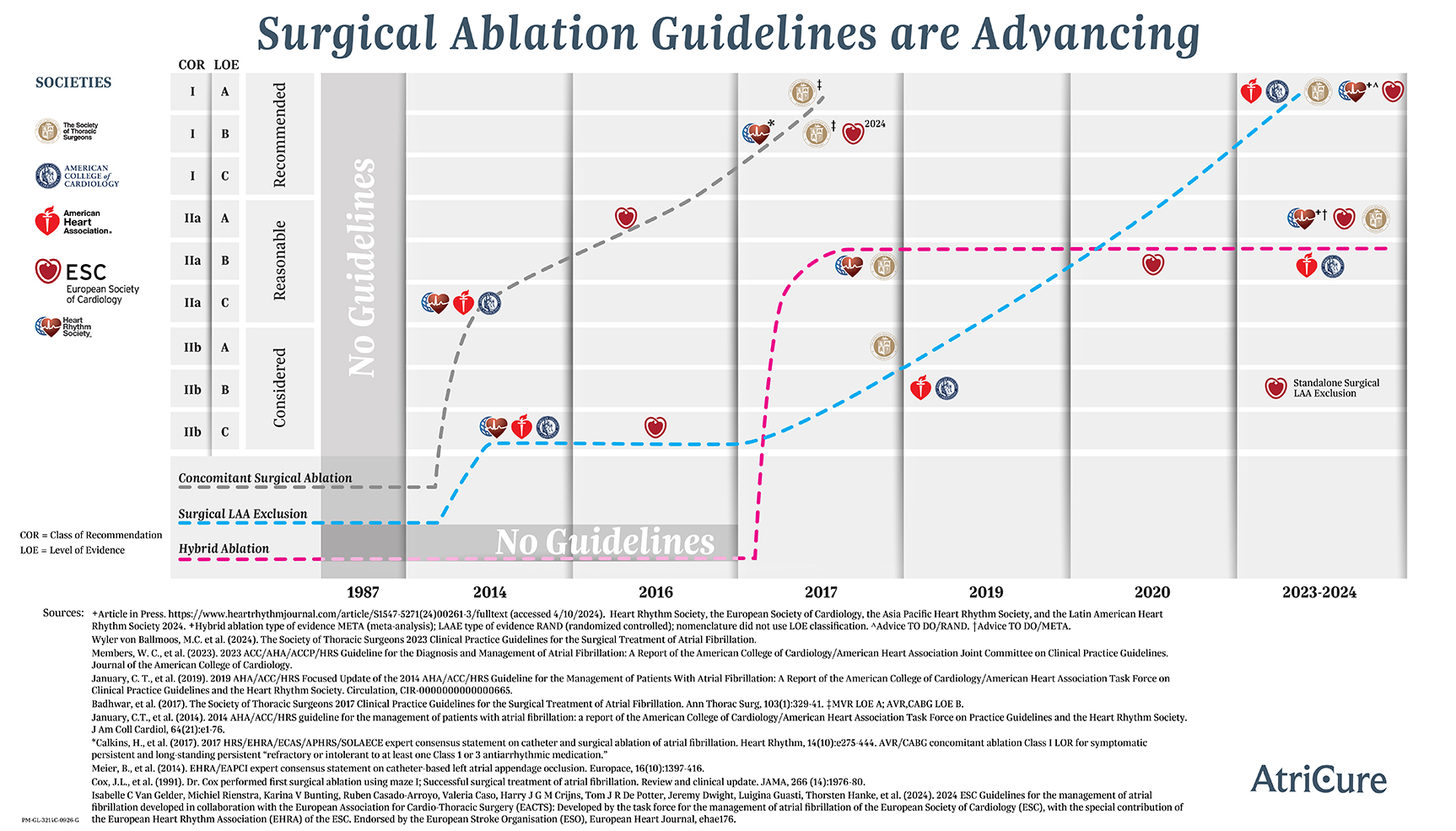-
Healthcare Professionals
-
Therapies and Procedures
-
Concomitant Surgical Ablation Therapy
- Ablation Sensing Unit & Switch Matrix
- cryoFORM® Cryoablation Probe
- cryoICE® BOX V6
- cryoICE® Cryoablation Probes
- Isolator® Linear Pen
- Isolator® Synergy™ Access® Clamp
- Isolator® Synergy™ Clamps (OLL2/OSL2)
- Isolator® Transpolar Pen (MAX3)
- Isolator® Synergy™ EnCompass® Clamp
- Multifunctional Ablation Generator (MAG)
- Hybrid AF™ Therapy
- Hybrid Total Thoracoscopic Therapy
- Left Atrial Appendage Management
- Cryo Nerve Block Therapy
-
Concomitant Surgical Ablation Therapy
- Education & Training
- Clinical Evidence
- Product Labeling
- Resources
- Society Guidelines
-
Therapies and Procedures
- Patients & Caregivers
- About AtriCure
Concomitant Surgical Ablation Therapy
Atrial fibrillation (Afib) carries a heavy clinical burden, with patients experiencing a 5x greater risk of stroke1 and a 5x increase in heart failure.2 These patients also experience up to a 47% reduction in quality of life related to anxiety about medications and burnout from frequent doctor appointments.3-9
The 2024 ESC Guidelines for the management of atrial fibrillation, developed in collaboration with the European Association of Cardio-Thoracic Surgery (EACTS), have upgraded concomitant surgical AF ablation to a Class I recommendation.
AtriCure has a robust lineup of clamps, pens and probes that can be used for ablating cardiac tissue with either cryothermia or bipolar radiofrequency energy. Several AtriCure pens also have the ability to pace, sense, and stimulate.
BOXX Procedure
Treat AF With a BOX lesion Performed by the Isolator® Synergy EnCompass® Clamp and Reduce the Risk of Stroke* by Eliminating the LAA With the AtriClip® LAA Exclusion System.
The BOXX procedure allows the surgeon to follow a series of steps, performed during open heart surgery, to help alleviate the symptoms of atrial fibrillation and reduce the risk of future heart failure and strokes for the patient.
The procedure enables a surgeon, without the requirement to open the left atria, to:
• Isolate the posterior left atrial wall and pulmonary veins by creating a BOX lesion
• Exclude the LAA (to reduce the risk of future strokes originating from the LAA)
Two surgical devices are used in conjunction to perform the procedure: the Isolator Synergy EnCompass Clamp and the AtriClip LAA Exclusion System.
*Thromboembolic event originated from the LAA.
Treat AF With the Isolator Synergy EnCompass Clamp
The Isolator Synergy EnCompass Clamp is the latest addition to a robust portfolio of bipolar radiofrequency (RF) ablation devices.
Reduce the Risk of Stroke* by Eliminating the LAA With AtriClip Devices
AtriClip devices are the most widely sold Left Atrial Appendage (LAA) management devices worldwide, with more than 98% successful LAA Exclusion.
Learn More about
Concomitant Surgical Ablation Therapy Products
Page References
- Fukunaga et al. (2008) Fukunaga S, Hori H, Ueda T, Takagi K, Tayama E, Aoyagi S. Effect of surgery for atrial fibrillation associated with mitral valve disease. The Annals of Thoracic Surgery. 2008;86(4):1212–1217.
- Boriani G, Proietti M (2017) Atrial fibrillation prevention: an appraisal of current evidence. Heart (0):1–6
- Nazli C, Kahya Eren N, Yakar Tuluce S, Kocagra Yagiz IG, Kilicaslan B et al. (2016) Impaired quality of life in patients with intermittent atrial fibrillation. Anatol J Cardiol 16 (4): 250-255.
- Thrall G, Lane D, Carroll D, Lip GY (2006) Quality of life in patients with atrial fibrillation: a systematic review. Am J Med 119 (5): 448.e441-419.
- Hagens VE, Ranchor AV, Van Sonderen E, Bosker HA, Kamp O et al. (2004) Effect of rate or rhythm control on quality of life in persistent atrial fibrillation. Results from the Rate Control Versus Electrical Cardioversion (RACE) Study. J Am Coll Cardiol 43 (2): 241-247.
- Hoegh V, Lundbye-Christensen S, Delmar C, Frederiksen K, Riahi S et al. (2016) Association between the diagnosis of atrial fibrillation and aspects of health status: a Danish cross-sectional study. Scand J Caring Sci 30 (3): 507-517.
- Dorian P, Jung W, Newman D, Paquette M, Wood K et al. (2000) The impairment of health-related quality of life in patients with intermittent atrial fibrillation: implications for the assessment of investigational therapy. J Am Coll Cardiol 36 (4): 1303-1309.
- Centers for Disease Control Atrial Fibrillation Fact Sheet. https://www.cdc.gov/dhdsp/data_statistics/fact_sheets/fs_atrial_fibrillation.htm. Accessed Dec 2018.
- Annals of Emerg Med, 2008 Jan;51(1): 58-65, Epub 2007, April 27
- Badhwar, V. et al. (2017). The Society of Thoracic Surgeons 2017 Clinical Practice Guidelines for the Surgical Treatment of Atrial Fibrillation. Ann of Thorac Surg, 103(1):329-41.
- 2024 ESC Guidelines for the management of atrial fibrillation developed In collaboration with the European Association for Cardlo-Thoracic Surgery (EACTS). European Heart Journal. ehae176.
- Mean closure rate among the 3 studies Is 98.1% per data on file al AlriCure Inc. Ailawadi G. el al. J Thorac Cardiovasc Surg 2011:142:1002-9. 1009.el: Gerdlsch. M.W. el al. Innovations (Phi1a). 2022;17(6):463-470: Cartledge R. et al. Interactive CardioVascular and Thoracic Surgery 34 (2022) 548-555
PM-EUMEA-2662B-1026-G


